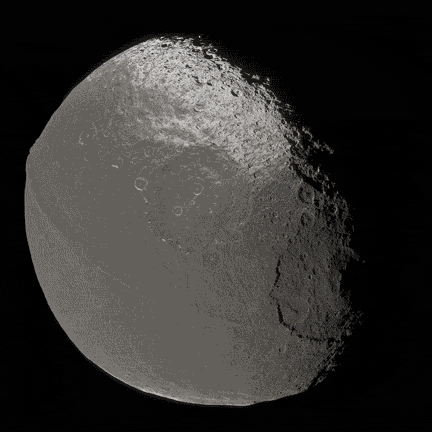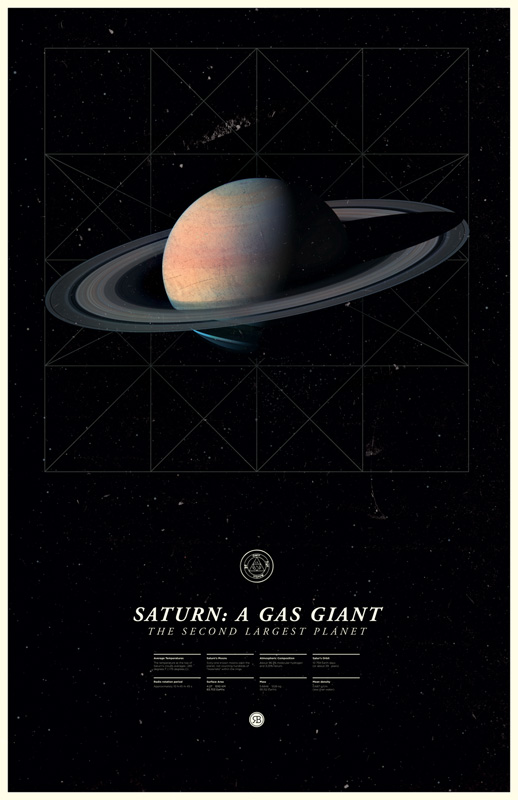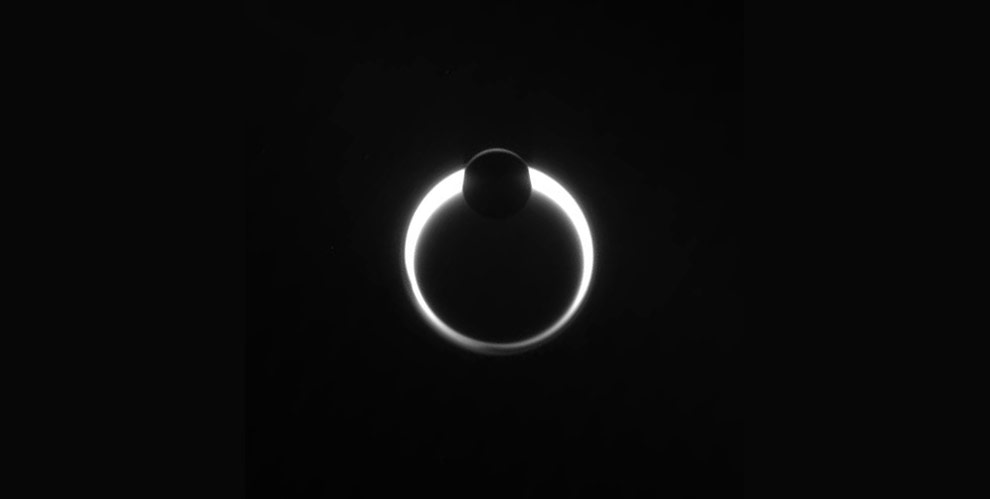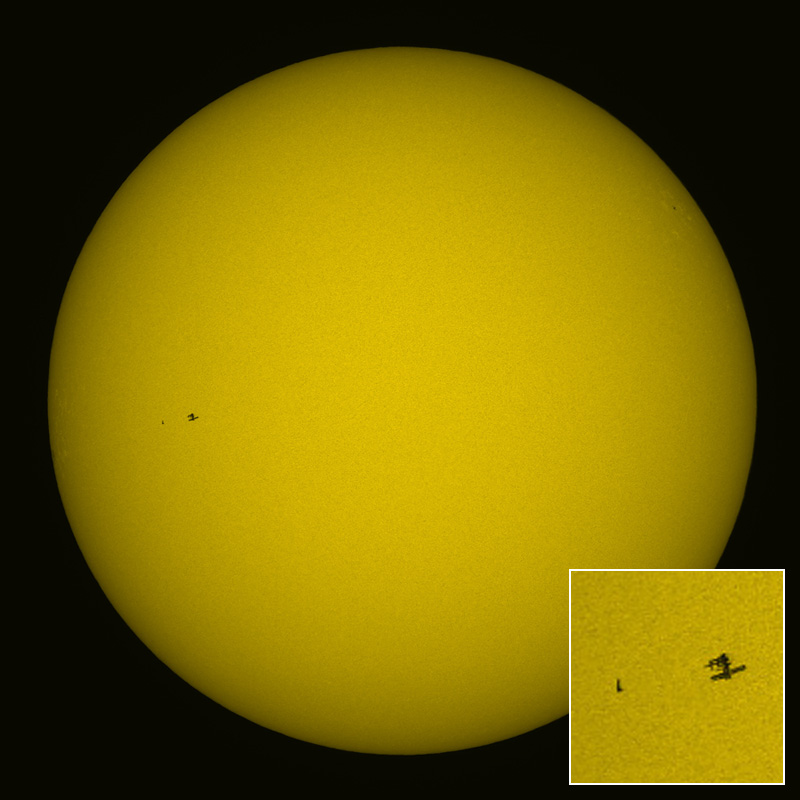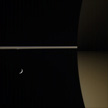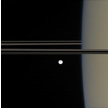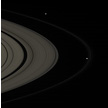 This is one of the tiny moons of Saturn seen up close around Jan 27, 2010 by Cassini. In case you do not recall, it is the moon responsible for some of the best ring disturbance movies of the mission.
This is one of the tiny moons of Saturn seen up close around Jan 27, 2010 by Cassini. In case you do not recall, it is the moon responsible for some of the best ring disturbance movies of the mission.
Rounding the Pole of Iapetus
Ross Berens Ruins My Dreams
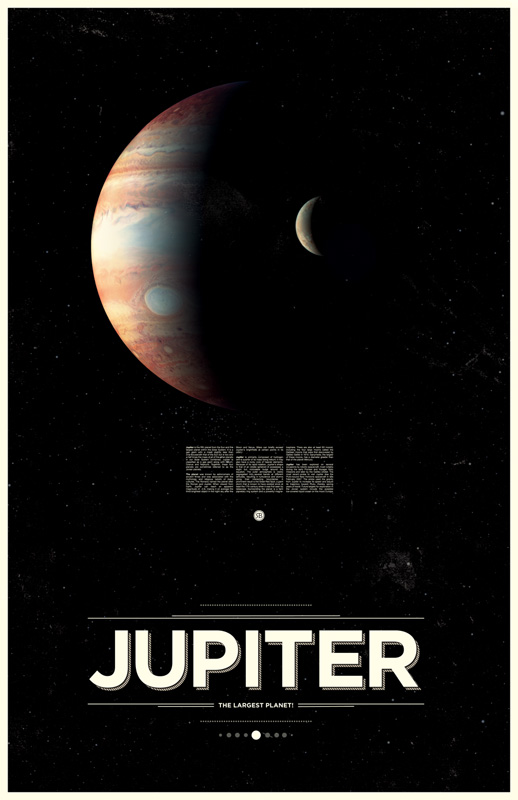 I had really always thought it would be so cool to do a poster set with great design for each of the planets. I actually started a design for the Cassini at Saturn mission, but have yet to complete it. Sure enough someone comes along and knocks the whole system out in one fantastic series. Beat me to it!
I had really always thought it would be so cool to do a poster set with great design for each of the planets. I actually started a design for the Cassini at Saturn mission, but have yet to complete it. Sure enough someone comes along and knocks the whole system out in one fantastic series. Beat me to it!
The funny thing about doing the whole Solar System is that you will not likely have too many takers for Uranus or even Pluto. But the design on some of these makes it pretty tempting to grab just for the overall design. I can’t wait to email Ross when New Horizons gets to Pluto and it looks nothing like what is shown here. A gorgeous inclusion of the hypothetical ring some expect to find when we get there, but where are the 3 moons?
I would be a fool to not include Saturn. The exclusion of the Galileans at Jupiter, no Charon on the Pluto poster and the absence of Titan here on the Saturn poster... I wonder if I sense a moon series coming? Put me down for a copy of Io.
Prometheus, Small Moon of Saturn
 Prometheus is the small moon that shepherds Saturn’s outer “F” ring and causes those crazy waves in the particles that make up the ring itself. The phenomenon has been the theme of at least 3 different animations here on wanderingspace.net. The image above is what that small moon in those animations looks like from 60,000 km taken by Cassini on Dec 26, 2009.
Prometheus is the small moon that shepherds Saturn’s outer “F” ring and causes those crazy waves in the particles that make up the ring itself. The phenomenon has been the theme of at least 3 different animations here on wanderingspace.net. The image above is what that small moon in those animations looks like from 60,000 km taken by Cassini on Dec 26, 2009.
Back-Burner Image: Saturn Clouds
50 Years of Space Exploration Map
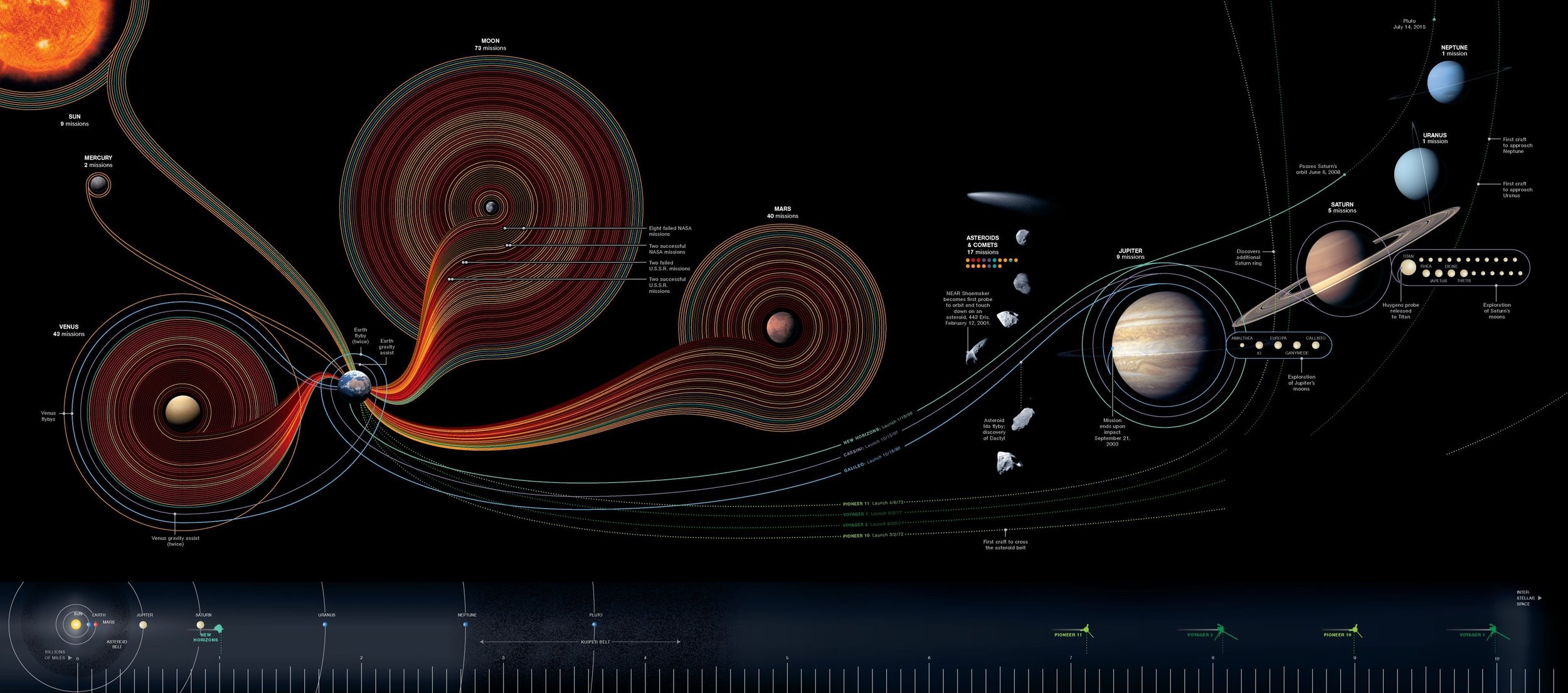 This is so nice, but I am furious that I didn’t get to design this. This is Information design at it’s best naturally by National Geographic. You can see 50 years of robotic planetary exploration at a glance. It even includes failed missions represented by darker desaturated lines. As far as I can tell the cream colored lines are US and the red ones are Soviet. Interesting to see how many of those lines go dark around Mars.
This is so nice, but I am furious that I didn’t get to design this. This is Information design at it’s best naturally by National Geographic. You can see 50 years of robotic planetary exploration at a glance. It even includes failed missions represented by darker desaturated lines. As far as I can tell the cream colored lines are US and the red ones are Soviet. Interesting to see how many of those lines go dark around Mars.
Now where does one purchase such a thing? Perhaps this month’s issue of NG? Here is the link to it on their site complete with zoom viewer and them some kind samaritan posted a hires version to flickr.
A Saturnian Aurora Captured
 Astro0 (a contributor to unmannedspaceflight.com) had been looking through a 159 frame set of images that showed a tiny portion of Saturn's sunlit limb. He animated it just to see the effect and happened upon a pretty nice animation of a Saturnian aurora (click here for the animation). Which is likely the first time we are seeing an aurora on another world so clearly animated.
Astro0 (a contributor to unmannedspaceflight.com) had been looking through a 159 frame set of images that showed a tiny portion of Saturn's sunlit limb. He animated it just to see the effect and happened upon a pretty nice animation of a Saturnian aurora (click here for the animation). Which is likely the first time we are seeing an aurora on another world so clearly animated.
To be clear… the spots that stand still in the animation are artifacts of the images. The streaks are stars seemingly flying by due to Cassini’s cameras being trained on one spot as it and Saturn itself are moving through space. Astro0’s blog can be found here and I suspect will soon feature a post with more details on the animation in the very near future.
Saturnati XXIII
 Image by Gordan Ugarkovic.
Image by Gordan Ugarkovic.
The Enterprise Emerges From Titan
 Nice example of science meets Hollywood.
Nice example of science meets Hollywood.
Partial Eclipse of Titan
Saturn at Equinox
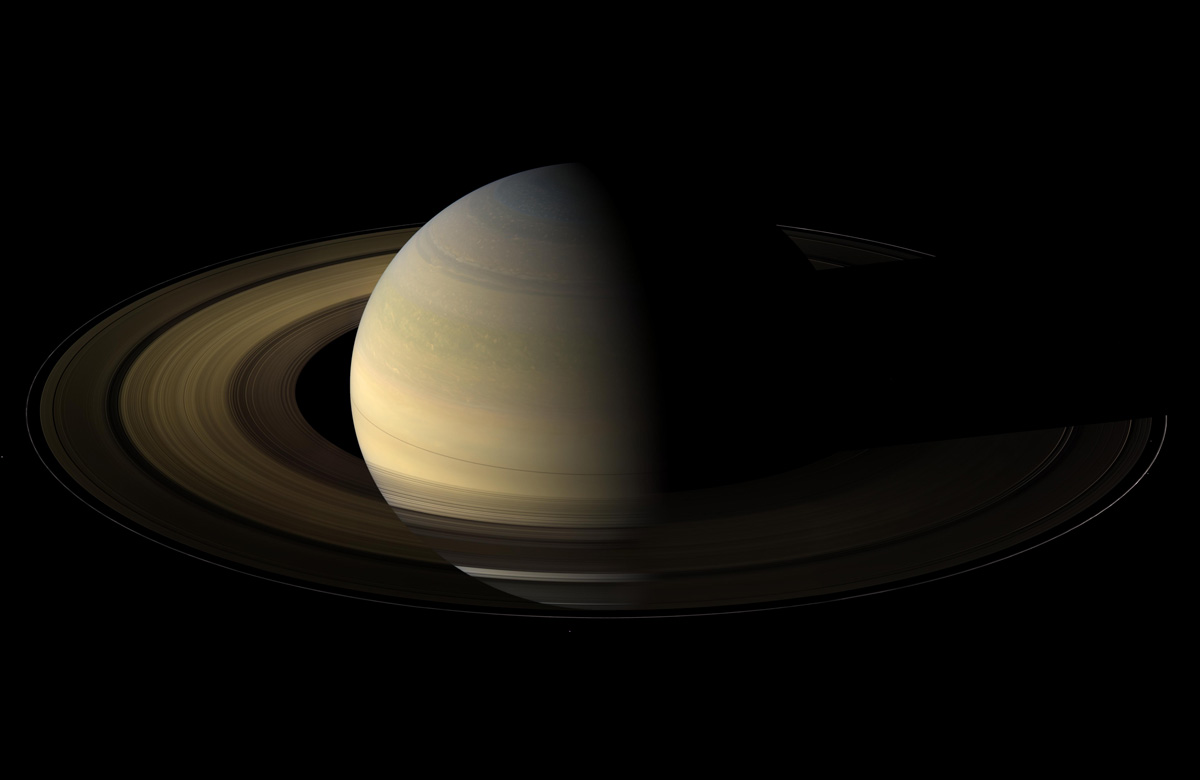 An official NASA image released of Saturn at equinox. You can only see Saturn like this approximately every 15 Earth years as it takes Saturn that long to reach a point in it’s orbit where the ring plane is directly aligned with the sun light. Turning the usually dramatic ring shadows that are cast along Saturn’s cloud tops into a thin black line running around it’s globe.
An official NASA image released of Saturn at equinox. You can only see Saturn like this approximately every 15 Earth years as it takes Saturn that long to reach a point in it’s orbit where the ring plane is directly aligned with the sun light. Turning the usually dramatic ring shadows that are cast along Saturn’s cloud tops into a thin black line running around it’s globe.
This composite took 75 separate images of Saturn to complete the full hires version seen here at planetary.org.
Saturnati XXII
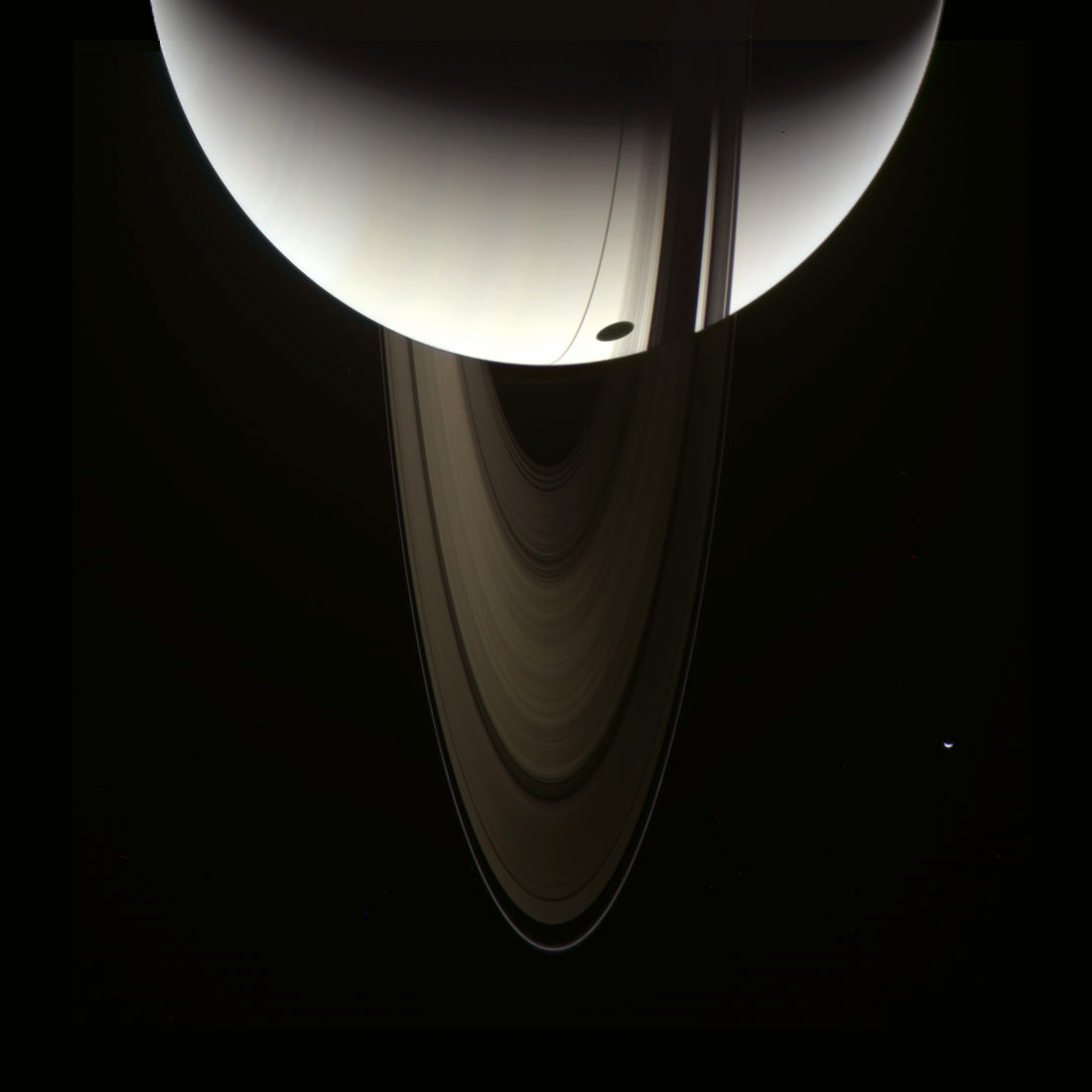 Emily Lakdawalla recently posted some images from the Cassini raw image database and I noticed that she had posted 2 similar images taken the same day. One had Saturn’s disc over exposed and the other had Saturn exposed much better with the rings too dark and lacking detail. These crescent images often make it difficult for Cassini’s cameras to get a single exposure with both elements with proper exposure because Saturn’s disk is so much brighter than the back-lit rings.
Emily Lakdawalla recently posted some images from the Cassini raw image database and I noticed that she had posted 2 similar images taken the same day. One had Saturn’s disc over exposed and the other had Saturn exposed much better with the rings too dark and lacking detail. These crescent images often make it difficult for Cassini’s cameras to get a single exposure with both elements with proper exposure because Saturn’s disk is so much brighter than the back-lit rings.
So i retrieved the images from the same day, recompiled them, did a little manual color balancing based on one of Gordan Ugarkovic’s recent crescent Saturn images and finally merged the two elements together. So, in reality the rings were taken at a slightly different time than Saturn’s disc was. However, since Cassini takes it’s color images one filter at a time (red, green and then blue), that is really true of any color image compiled from the mission database.
Also visible in the image is a small crescent Tethys and Titan’s shadow on the cloud tops.
Saturnati XXI
 Another by Gordan Ugarkovic.
Another by Gordan Ugarkovic.
Rings Not Entirely Flat
 Recent observations of Saturn’s rings from Cassini reveal some vertical structure to the rings. Shown here are disturbances caused by Daphnis, a small moonlet that orbits within the Keeler Gap of the rings. We have seen much of these kinds of disturbances in the rings from tiny moonlets, but the Saturninan equinox finally provides us with an angle of sunlight that reveals such structures from the long shadows they cast. The tallest shadow seen at right is Daphnis itself.
Recent observations of Saturn’s rings from Cassini reveal some vertical structure to the rings. Shown here are disturbances caused by Daphnis, a small moonlet that orbits within the Keeler Gap of the rings. We have seen much of these kinds of disturbances in the rings from tiny moonlets, but the Saturninan equinox finally provides us with an angle of sunlight that reveals such structures from the long shadows they cast. The tallest shadow seen at right is Daphnis itself.
iPhone Skins Featured on feulyourcreativity.com
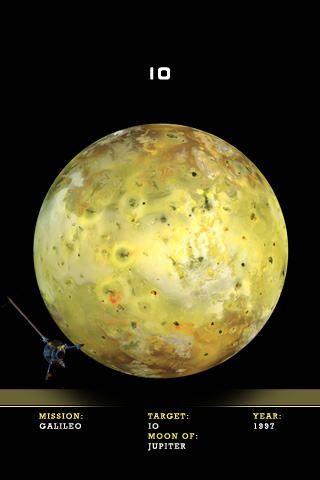 Not to re-post old material, but our iPhone planetary skins were recently posted to fuelyourcreativity.com for free download. So I thought I would just remind everyone and maybe direct a little traffic love their way.
Not to re-post old material, but our iPhone planetary skins were recently posted to fuelyourcreativity.com for free download. So I thought I would just remind everyone and maybe direct a little traffic love their way.
Shuttle and the Sun

 This image taken by Thierry Legault has been making the rounds lately. That bit of a speck seen on the Sun’s lower-right limb is the shuttle on the way to perform it’s current Hubble repair mission. The spacecraft itself can be seen in much greater detail at left and another image of The Shuttle with The Hubble Space Telescope nearby can also be seen on Thierry’s website here.
This image taken by Thierry Legault has been making the rounds lately. That bit of a speck seen on the Sun’s lower-right limb is the shuttle on the way to perform it’s current Hubble repair mission. The spacecraft itself can be seen in much greater detail at left and another image of The Shuttle with The Hubble Space Telescope nearby can also be seen on Thierry’s website here.
A quick google search of Thierry’s name reveals that he has been at this sort of thing before. Seen below is the Shuttle and The International Space Station as seen against The Sun in 2006. These transits happen in less than a second to a ground observer, so capturing this fleeting event is no easy task.
More Gordan U

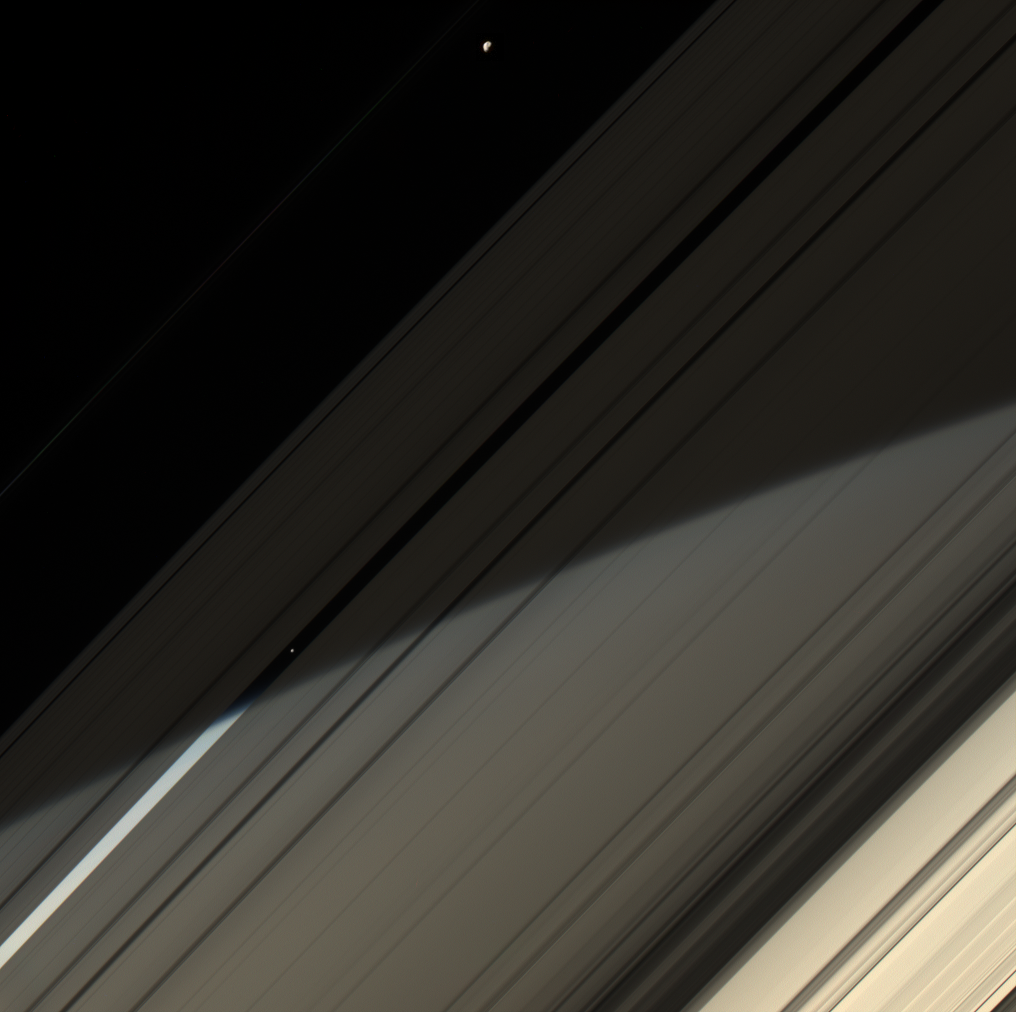

 Some recent posts from Gordan Ugarkovic. The first is just gorgeous, the second featuring Prometheus and Pan in the gaps, the third is also just real pretty and the 4th is two sides of Enceladus. The 2nd and 4th of these images are false color which we publish less often, but these were just too nice to deny.
Some recent posts from Gordan Ugarkovic. The first is just gorgeous, the second featuring Prometheus and Pan in the gaps, the third is also just real pretty and the 4th is two sides of Enceladus. The 2nd and 4th of these images are false color which we publish less often, but these were just too nice to deny.
Saturnati XX
Saturn Through the Eyes of Hubble
Gordan, King of Rock N Ice
 The King of Saturn imagery does it again. One of the key images that inspired me to even start this blog was the NASA officially produced image of Mimas against ring shadows. This one is pretty much just as stunning. Gordan has knocked out a few other Saturn images recently, all worth a look at his flickr stream.
The King of Saturn imagery does it again. One of the key images that inspired me to even start this blog was the NASA officially produced image of Mimas against ring shadows. This one is pretty much just as stunning. Gordan has knocked out a few other Saturn images recently, all worth a look at his flickr stream.
